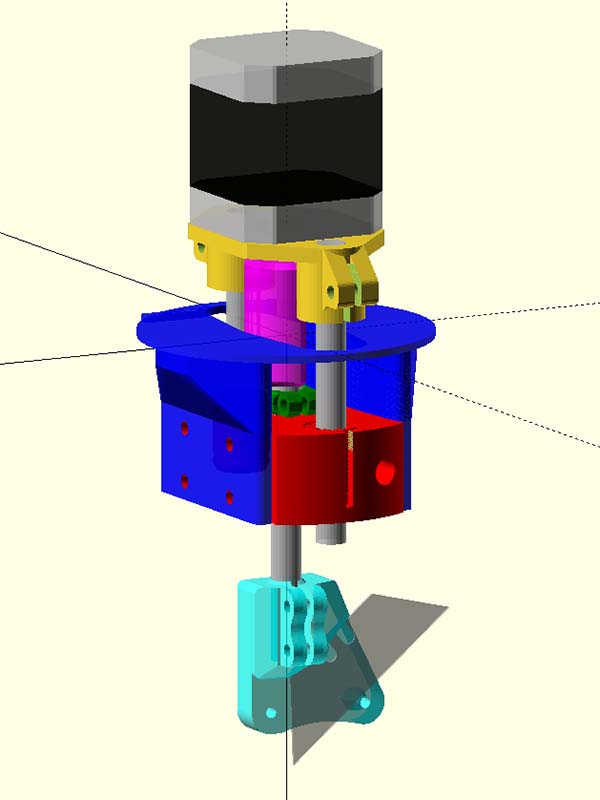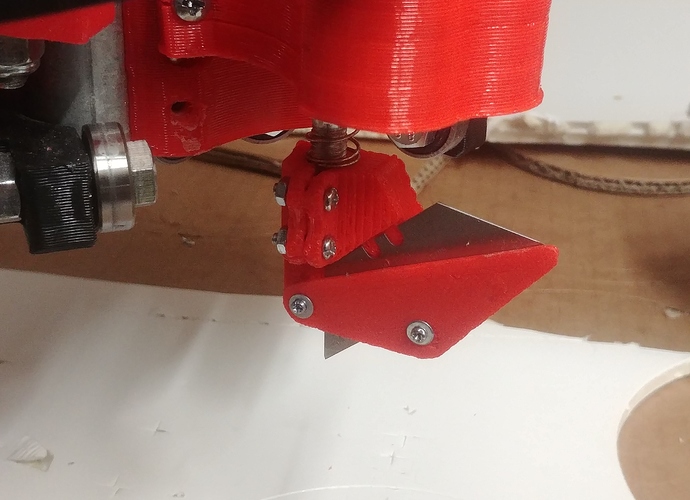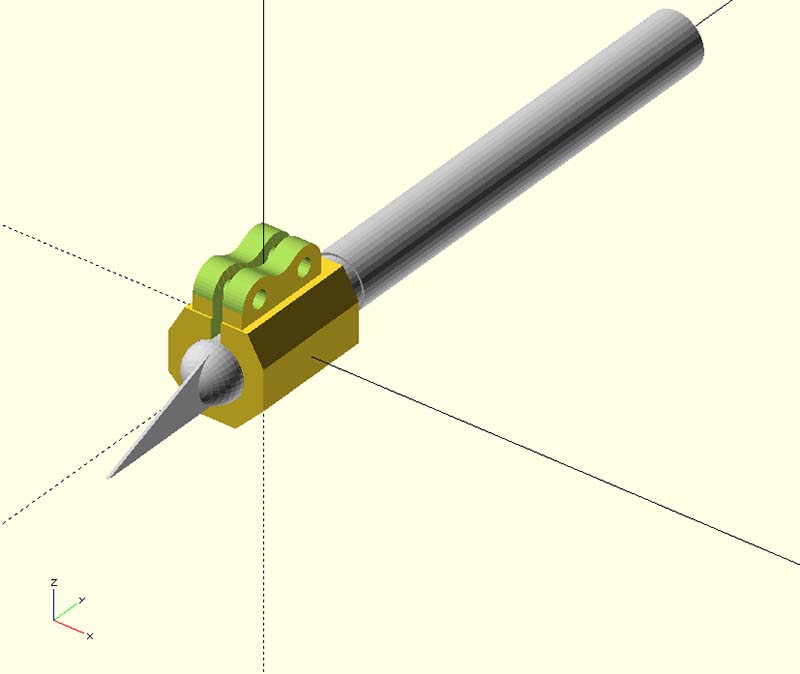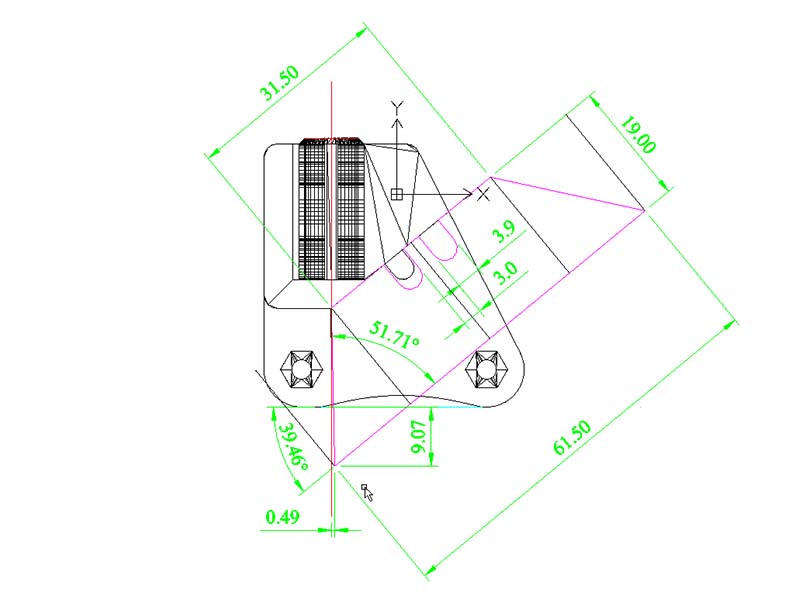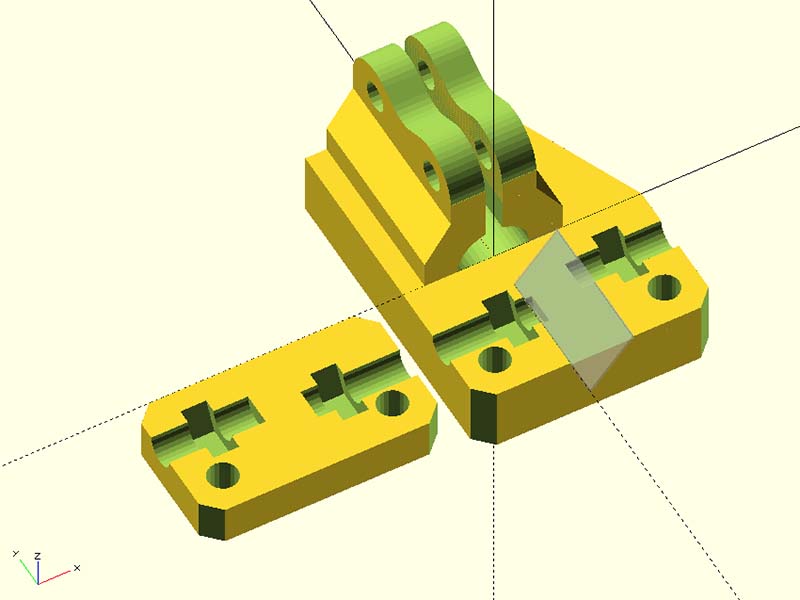Cool, looks pretty close to optimal now. Will try it ASAP and let you know how it goes, thanks.
It was fun working on this. Thanks for getting this project started & getting most of the bugs out.
I made some progress on my quick mount adapter for this. My main problem was making the mount shorter and closer to the blade. The top of the adapter needs to have a lip to rest on the top of the quick release mount. I had the bright idea to make it a two part mount so I could drop the main red part down lower & have better stability. I still need to add the quick release files to the assembly to see if I need to adjust it down any more, but looks like it should work. I will bolt the blue & red part together with M3x50mm screws. I cut slots around where the bearing inserts to make it easier to insert them. I probably will use a metal 8x5 coupler but used https://www.thingiverse.com/thing:964680 for now. The pineapple coupler was too wide.
I committed to try this now and will try 3 different types of bearings. folgertech had 20% off today, so I ordered 8mm smooth drill rod http://bit.ly/2zzQoqq
drylin® Igus RJ4JP-01-08 http://bit.ly/2jkUW92 (These are the lubricant free dry bearings)
LM8UU Linear Bearing http://bit.ly/2Bjuchm
LMF8LUU (x2) bearings http://bit.ly/2i3EzkA (This looks like they maybe interesting)
I am also going to order the motor & some other parts from Ryan once I settle in on what else I need.
Good to hear. It’s been a rewarding project for me too, learned loads. Your blade holder is on my cutter now, and looking good. It’s a big improvement. It’s more rigid and has better blade positioning support. The end of the rode is about 40% closer to the blade tip, which is a big deal for rigidity. I also like the integrated blade guard for the back end. I’ve scratched the redesign job off my list!
[attachment file=48465]
I’m looking forward to seeing your version working. I’ve been thinking for a while now about going to a quick release tool mount.
Since I put the rigid alu coupler on and installed the new blade mount, my blade tip x/y tolerance has improved a lot. Watching the bushings updates closely, but I’m pretty happy with the accuracy now, so it’s not as urgent. I do want further improvements so please keep going with this.
I had little issue cutting out rings - there was no way to control cut order, which needed to be fixed really. Found myself holding the ring down because the outside cut was made first in each case, leaving the piece to move while the inside cut was done.
New branch on the fork of gcodetools here:
Will merge when I’ve implemented this as an option. At the moment it’s turned on in that branch.
You select the paths in order you want them cut, and the gcode will cut in that order. Quite a big missing feature from gcodetools I think considering how complete it is otherwise.
If you’re interested, the way it works is it renames the paths according to select order, then gets gcodetools to sort the path dictionary by path id before generating gcode.
I was. Thanks.
Glad it is working for you & I have had to print very little to test it so far. While walking thru some hobby stores today, I had the idea that an x-acto knife might work with this, but not sure if it would be as strong a blade cut as what you are using. I did 2 design versions, one with the knife and one with just the blade. Using just the blade is probably a better way to go as the part is smaller and you would not have to use a non-standard 3d printed bushing. The diameter of the Number 2 knife with number 2 blade I was using, http://www.xacto.com/products/cutting-solutions/knives/detail/X3202 is a measured 11.15mm OD. Actually the #1 knife measures 7.96mm OD which should be close enough to 8mm, but I was not sure that would be strong enough. Anyway, here are a couple of screen shots of the design for reference. For just the blade mount I would add just a simple cover with 2 screws to hold it in. For the single blade mount, I added the notch in the center to hold it in place. I just realized that using the whole knife would make the tip of the blade offset from the center, but using just the blade would not.
Think I have simplified my mount adapter, at least cut down considerably on the amount of plastic to use.
Good thinking. It’s great when you challenge yourself on a project to see the ideas flood in. On this occasion I personally have my doubts. You mention why the whole knife option won’t work - there needs to be a zero offset.
As for the blade only, we’re on the same page, however I think for a couple of reasons an Olfa snap off might be preferable. This is something I’ve mentioned in my blade holder update notes on the Thingiverse page - the idea being to copy the TOCK approach and use Olfa blades.
I’ve found cutting thick material presents a few challenges. The angle of the blade w.r.t. the material has a big impact on success. See this post for some experiments with blade angle. What I found is a shallower cutting angle is more efficient.
I guess there are two reasons for this: more blade in the material, and the shallower the angle, the bigger the component of transverse movement or slicing action. If you think about sticking a blade in to thick cardboard with the blade edge perpendicular to the direction of travel, you can imaging it will be quite tough to move because there will be no slicing at all. Same is pushing a knife straight down through a tomato without any lateral movement.
X-acto blades offer a very steep cutting angle (closer to perpendicular) so while there are advantages in terms of reducing over-cut on thick material, there would be much more resistance on the cut. With Olfa snap-off blades, you get super cheap - I find changing the blade often is needed more than you might think. The challenge might be that without any holes or indents in the blade piece, having it mounted securely. Perhaps a spring clamp like your rod clamp in the blade holder?
That is an interesting design. I had not seen that before. I do not have any software that will open the file types he is using. Like you said the challenge would be to hold those blades in place since there are no holes. You might be able to use a screw on the top with a captive nut and the screw would press against the blade to hold it in place. Would just have to make the plastic thick enough on top to insert a nut. Would a jam nut be sufficient, or would this need to be a locknut? How does that idea sound?
The box cutter blade does seem to be the best solution for this. The #19 x-acto blade does have a shallower angle. From measuring the photo of it, I get 34 degrees, but that number might be a little different. It is not enough blade to cut thick material, but might be a good option for cutting paper. Again from measuring the photo, the cutting depth of that blade is a hair over 6mm. After your discussion, don’t think I will use this, but might still put it on thingiverse in case someone else wants to try it.
Where I use to work, we had a plotter that used rolls of paper & a cutter blade that cut each drawing off. We used a ceramic blade that stayed sharper much longer. Here is a pack of 6 ceramic box cutter blades for $28.99. Quite a bit more expensive, but they claim to last 10x longer than the metal blades. http://amzn.to/2Bg4b1w Not as cost effective as the steel blades, but for some people it might be worth the cost. Here is a blade with a titanium edge with a 5 pack for $4.69 or 50 pack for $19.48. http://amzn.to/2Acj9Xn These might be worth trying. I can not find how much longer they are supposed to last.
Great work, guys! I’m really a noob at this drag-knife stuff but I may have a tidbit that could help with the ordering of cuts…
Shurakair, over in my FliteTest needle-cutter thread, shared his method of ordering cuts in Inkscape/Gcodetools that seems to work a champ for generating gcode from pdf RC plane plans…
He made a template file ([attachment file=48505]) that allows the different cuts – score, inside, outside, etc. – to be placed on their own LAYER… allowing for cuts of differing depths, in a specified order. This template is sized for DTFB (20" x 30"), in portrait orientation, but can readily be altered to your need. Put it in your Inkscape templates directory, rename it to “default.svg”, and then IMPORT (vs OPEN) your content. Place your different cut paths on their proper layer and gcodetools will cut them in the specified order. – David
FoamBoard.zip (5.71 KB)
I think it would work fine. The main pressure on the blade is from the edge to the back. There isn’t much force to pull the blade out from normal operation, although it shouldn’t be allowed to move at all or it might work loose. Happy to try out any designs that pop out!
My experience of ceramic blades (kitchen knives) has been that the lateral brittleness out weighs the extra durability of the edge. It seems likely to me you wouldn’t try to any turns with the blade left in because there’s no telling when it would snap the blade. It only needs the very tip to break a little bit as that is the most important part.
As for cost, I can get 50 olfa blades for £22, with 7 usable break off tips per blade, so 6 pence per blade. If we imaging the blade lasts 1/10th the time, it’s still far cheaper than ceramic I believe.
Aha, very cool. Thanks for sharing. I really like this approach and might not have bothered developing those changes if I’d seen it, but actually I’m glad I did.
By the way, I think I was a little unclear - manual path selection is working great in my new branch, you just can’t turn it off. Next is to introduce a checkbox to enable/disable.
I do like being able to control cut order via selection order, so will have to get to grips with both and have a think.
By the way, fusion 360 slicer also outputs the markings and cuts with different colours (red/blue) be default. I’ve also been working on a method of automating the workflow based on this, but don’t know how to detect inside/outside cuts to automate the cut order, so stopped in favour of the manual path selection.
Since you’re here dkj4linux, and I’m sure you know this project is different from a drag knife, I’ve been able to cut foam pretty well, including of course any angle (something drag knives struggle with) but the angle of the blade means there will always be over cuts on the cut side. Therefore it won’t ever replace the marvellous needle cutter, for which I have ordered myself all the bits I need.
Thanks, James. Yeah, I knew this isn’t just a simple drag knife. I’m really excited about this development thread but I’m far too gone mentally to contribute much at this point… glad I could throw something in to help. At one time I was interested enough to actually buy one of the pricey Donek tools but hated the fact that the only way to handle corner compensation seemed to be their silly MS Excel postprocessor… and the needle cutter was coming along nicely so I never did anything with it. I’m currently struggling mightily to get my tools/machines setup and a work/play routine established after moving into my new/old house but do have my Prusa printer setup so this tangential knife setup may be just the ticket to help me get going again. Keep up the good work! – David
I took some dimensions off the cutoff blades I have, but not sure they are the olfa blades. I attached an image to show those dimensions and different angles of cut height depending on the mounting orientation of the blade. A limitation I see with those blades is depth of cut. At 40 degree cut which is close to what the other blade is there is 5.35mm depth where the box cutter blade is 8.59mm. Do these olfa blades come in different widths? I could probably make the dimensions for the blade variable in the openscad design.
I also attached an image showing the key dimensions of the box cutter blade holder (using Stanley blade as reference). I left the dimensions and angle of cut the same as the original design, but could change them easy enough. Using the Stanley blade there is probably .5mm offset from the centerline of the shaft which might not be enough to worry about. I would have thought those blades would be a nice 45 degree angle instead of the odd 51.71 degrees I come of with from measuring them. I am using a digital caliper to measure them.
What cutting angle would be optimal for cutting cardboard or foamcore? On that TOCK you referenced, looks like he is cutting that cutoff blade to a 60 degrees or so and sharpening it to get a longer depth of cut.
I am not sure any more to be honest. My experiments with a more vertical cutting angle were with the drag knife. I’m wondering if I need to try again now with the tangential knife if a steeper cutting angle works. It would help with turns and over cuts.
It seems there are at least two different angle systems in blades from Olfa. There are the ones we’ve been looking at, and also an ‘art blade’ steeper version. This second one has a 30 degree angle according to the shop page. I can get these on ebay UK, 10 for £5, 6 usable tips each. They seem like a better choice even if you mounted at different angles because there is overall less blade in the way. I do not believe there will be a blade strength issue at all with these by the way.
Regarding your question about depth of cut, the pointier blades seem to have a slight advantage there too, being 9mm each of blade length, and less re-orienting to maximise cutting depth.
How about something like this? I have adjustments for the blade size and a few other dimensions. I have it set to use an M5 screw & Jam Nut as it seemed like a good size to use. A lock nut or regular nut will increase the height more. I have the shallow cut blade shown, but could use the steeper cut blade also. I show 2 views of it in one image. The m5 screw might not be necessary as I have the cutout for the blade at .3mm depth which should be the half the blade thickness. The cover itself might be enough to hold it. I guess the M5 screw would give the blade less chance of coming out.
Great to see more designs & thanks for sticking with it.
I think it should hold. I take it you put the cut out only on the holder side so the cover will bend / clamp over the remaining 0.3mm when screwed on? Thinking about the TOCK use of Olfa blades, with the blade vertical as you have it here, as you pointed out before there is very little cut depth available, which may be less of an issue with the TOCK because it oscillates.
Thinking a bit more, I think the 30 degree blade will actually work much better in the tangential knife than it would in a drag knife. Also because of the cut depth, I think I would be inclined to try your design modified for it first. I’ve ordered some of the blades - should be with me Friday.
On bushings/bearings, I’ve ordered a 45mm LMU8 for the bolt, and when it arrives I will go in search of a nicely fitted rod to try to minimise the lateral play. It occurred to me that the lateral forces on the shaft might be quite wearing on the PLA bushing.
What are the width of those blades, 9mm? The one’s I am using are 7.21mm & I add .2mm for clearance. I was thinking of using set screws along the side also, but dismissed that idea thinking that was not enough support. I then realized that might actually be a better idea & looks a lot better. The nut & screw are sandwiched between the cover & the holder. Here is what I am thinking. This is using 2 M3x12 screws with jam nuts.
Well i
Seems like a great idea worth trying. Any scope for sneaking in a 3rd hole next to the rod clamp. You would need to re-work the blade cover piece to go up there. Only because with two holes in a line tightening the side screws might cause the blade to want to tilt and hinge up the blade cover.
Also found this: https://grabcad.com/library/drag-knife-cnc
